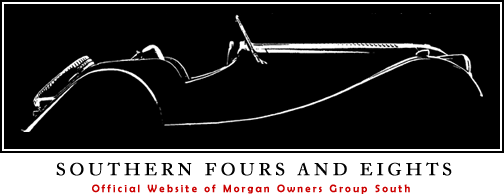The Smiting of the Knockoffs (www.roadandtrack.com)
If you buy an old sports car with wire wheels and those classic Rudge-Whitworth center-lock hubs, you may need a bigger hammer.
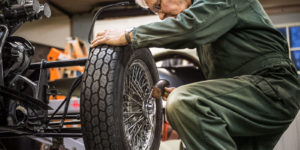
BY PETER EGAN
There are people who love puzzles and brainteasers, but I am not one of them. I hate having my brain teased. It’s already suffered enough. So when I ordered a new set of chromed knockoffs for the wire wheels on my 1965 Morgan project car, I eschewed the original bare variety and got ones with writing and instructions all over them. They arrived today, and they’re beautiful.
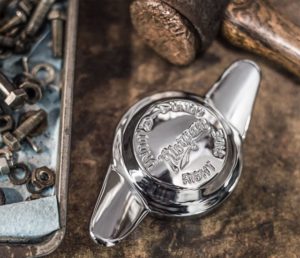
There’s “Morgan” script across the center, with directional arrows that say “undo” to show you which side to smack when you remove a wheel. They’re also marked “right side” and “left side,” so you don’t mount them on the wrong side.
As an aging British-car buff who occasionally puts the Grape Nuts box in the fridge, I find this idiot proofing a great solace. But if you’ve never owned a vintage sports car, you may be wondering what this directional fuss is about.
Let me explain: The traditional wire-spoked wheel is typically restrained from flying off into space (or a cornfield) by something called a center-lock hub, a device patented early in the 20th century by Rudge-Whitworth, a bicycle (and, later, motorcycle) manufacturer. It permitted a then miraculous quick change of flat tires simply by sliding a wire wheel onto a tapered splined hub and securing it with a threaded cap. “Ears” were later added to the cap to make it easy to hammer it on and off without using some huge oddball wrench.
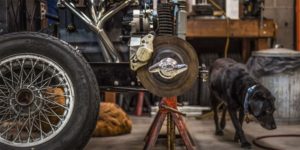
Sounds simple, but carefully matched inner and outer tapers were needed to center the wheel and lock it against the hub so the drive splines didn’t take a beating. The outer taper also fitted inside a groove in the cap so that “epicyclic” movement (see Ptolemy’s treatise on hula hoops) of the rotating hub would tighten the spinner.
I’m told by engineer friends that an ever-moving stress point on the outer taper (with the car weighted) causes the male hub to squeeze the female knockoff opposite the direction of rotation. But I like to think of it, for my own sanity, as a smaller inner circle (wheel hub) rotating faster than a larger outer one (loose knockoff), which tends to drive the threads home. In any case, the hubs on the left side of the car require standard right-hand threads and those on the right use “backward” counterclockwise threads. These thread directions are reversed on center-lock hubs on the Lotus Elan SE (for instance), where the knockoff fits inside the wheel center, but most conventional knockoffs are loosened by hammering down the forward ear on both sides of the car.
Hence all the markings and arrows on my Morgan spinners. Hammering them in the wrong direction—or mounting your hubs on the wrong side of a car—can cause big trouble. Wheels come off; prominent citizens go missing.
By 1912, this clever quick-change system was all but universal on the GP grids of Europe, and by 1922, Carlo Borrani was building his own exquisite hubs and wire wheels in Milan under license to Rudge and selling them to the great racing teams— Alfa, Auto Union, Mercedes, etc.
Wire wheels remained the standard in sports-car and F1 racing until the early Sixties, when stiffer aluminum and magnesium wheels came along. Knockoffs continued to be used on racing cars with “solid” wheels, such as the Cobras and Ford GT40s. On the street, however, the spinners became emasculated and lost their distinctive and useful knockoff ears to safety regulations in the U.S. and Germany in the late Sixties, becoming “wrench-offs.” (Apparently, legislators had been traumatized by the slice-and- dice hubs on the chariot in Ben-Hur and James Bond’s Aston.) Too many enthusiasts, though, knockoffs and wires still define what a proper sports car should look like.
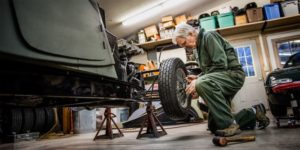
So it was no coincidence that my first sports car—a 1960 TR3 bought in 1967—had them, along with the obligatory leaky side curtains and primitive door latches. My current Morgan also shares these three key elements, so you can see, I’ve learned exactly nothing in 49 years. Actually, this is my fifth British sports car with knockoffs, and I still have my original, massive three-pound Thor copper knockoff hammer—which looks like something a Neanderthal would use to kill a mastodon.
Knockoff hammers themselves have considerable charm and are probably collectible at this point. Mine is a bit heavy, because I use it for bludgeoning all kinds of things in my workshop, but they also come in lighter weights with lead and rawhide tips, which are easier on virgin chrome. So are the shot-filled, plastic dead-blow hammers, but they look wrong. In an onboard tool kit, a two-pound lead hammer works nicely
And how hard must one smite those knockoff ears? Some say gently, because, after all, they’re self-tightening. But I’m among those who believe you should strike just hard enough to get a “solid sound,” but not so hard that all the dried cow manure falls off the bottom of your car.
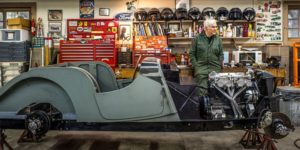
However you do it, there’s nothing quite as satisfying as smacking a knockoff. It feels like an ancient, embedded human prerogative, like releasing an arrow from a longbow or skipping a stone across a lake. If you’ve never owned a car with knock- offs, you probably owe it to yourself and your ancestors to get one. Knockoffs provide both tactile involvement with your car and participation in one of the sport’s most sacred rituals. Without which, as Jim Morrison would say, true sailing is dead.
